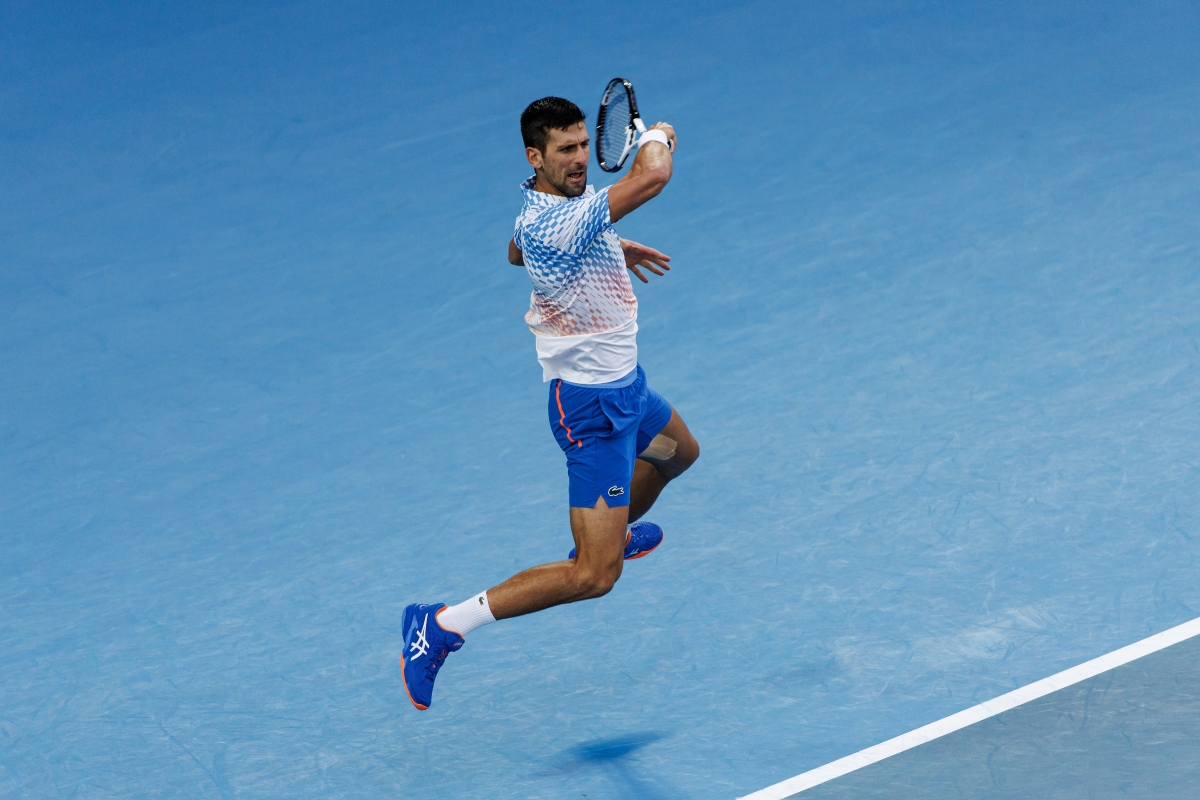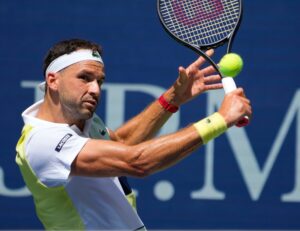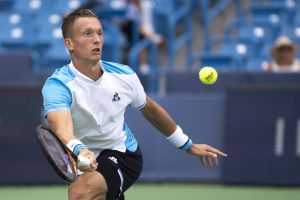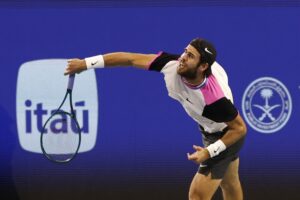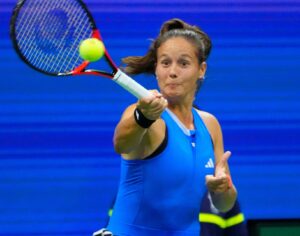The term “The Big Three” was always a big misnomer. “The Huge Three”, “The Gigantic Three” or even “Three Gods” (in homage to George Kimball’s seminal boxing book, “Four Kings”, about the great middleweights of the 1980s) would have been more accurate. There will almost certainly never be another trio of players of roughly the same age and playing generation who win at least 20 Majors each.
Nevertheless, it is entirely possible that men’s tennis will again be largely dominated by three players and nearly three months into 2023 it is starting to look like those three players could come from three different tennis generations: Novak Djokovic; Daniil Medvedev; and Carlos Alcaraz.
Novak Djokovic – The Big One?
Of course the Big Three are now down to the Big Two, following Roger Federer’s retirement last year, and it is even possible to argue, given Rafael Nadal’s continuing (indeed worsening) injury woes, that they have already been reduced to The Big One. At the start of the year, Novak Djokovic was imperious in winning his 10th Australian Open and 22nd Major in total (to bring him level with Nadal as the most successful male player ever) and his coach, Goran Ivanisevic, said afterwards that he is in such incredible physical and mental shape that he could remain at the top of the sport for another two or even three seasons.
It would be foolish in the extreme to write Nadal off completely, given that throughout his career his succession of remarkable comebacks have made Lazarus look like a complete amateur. However, it would be equally foolish not to acknowledge the toll that the serious injuries he has suffered throughout his career, far more than both Djokovic and Federer combined, have exacted a terrible toll. As a result, it is likely that he will focus the rest of his efforts for the rest of his career on winning the French Open, the Major he has made virtually his own, beginning with an attempt to win a remarkable 15th title at Roland Garros this summer.
It is certainly unlikely that Nadal will present as great a challenge to Djokovic or anyone else at the three other Majors, at none of which has he ever had the kind of era-defining success that he has enjoyed in Paris. He lost in the second round of the Australian Open this year, has largely struggled at Wimbledon over the last decade (notwithstanding his run to the semis last year, before he had to withdraw through – surprise, surprise – injury) and the hardcourts of the US Open, especially coming towards the end of the season, have always presented a particular problem for his increasingly brittle knees.
Consequently, it is probable that, Roland Garros aside, Djokovic will not face the same consistent threat at the Majors that Nadal has presented him with over the last two decades. Instead, it is likely that the main threats he will face, including to the possible Calendar Slam that he will be going for this year, will come from other quarters.
Daniil Medvedev Is Back – And How
Djokovic has already seen for himself, up close and personal, the threat that Daniil Medvedev will present to him. Last weekend in Dubai, Medvedev made it a hat-trick of titles in succession when he swept Djokovic aside in the semifinal en route to dispatching his compatriot Andrey Rublev in the final. In the process, he confirmed that he is back to his Major-winning best, which, lest we forget, was good enough to stop Djokovic completing the Calendar Slam in New York in 2021.
To paraphrase Oscar Wilde and the greatest quotation ever, to have beaten one of the world’s top 10 in straight sets could have been seen as mere good fortune; to have beaten two in two days is proof of Medvedev’s greatness. Against both Djokovic and Rublev, Medvedev confirmed that he has returned from his “lost year” of 2022, when he ascended to world #1 after reaching the Australian Open final only to gradually slide down the rankings throughout the rest of the year.
The biggest factor in that decline was probably the Grand Slam-sized hangover he suffered after losing the Australian Open final to Rafael Nadal from two sets up. Another complication was the ban from playing at Wimbledon that he and all other Russian and Belarusian players suffered after Russia’s re-invasion of Ukraine. Together, these “Major” difficulties seemed to add up to a year of confusion for the giant Russian.
Now, however, Medvedev is back, and how. He looks every inch the tennis-playing octopus that he is at his best, with his enormously long (and seemingly infinitely extendable) limbs meaning that he can produce winners from balls that other players would not even reach. That was evident again in Dubai, when at least once he was so far off court that he was no longer visible by television viewers but still played a cross-court winner that left Rublev looking absolutely dumbfounded.
Alongside Nadal and Stan Wawrinka (who, even more than Nadal, looks as if he is in the very twilight of his career), Medvedev is the only man currently playing to beat Djokovic in a Major final. That alone will be enough to plant the seed of doubt in the Great Serb’s head if they should meet again in another Major final this year.
Carlitos (Little Carlos) No More: He Is Already A Giant
There is some dispute about the precise meaning of “Carlitos” in Spanish. According to some sources, it means “manly” or even “heroic”. However, it is usually the diminutive (despite actually being longer) of Carlos and so more often than not is taken to mean “Little Carlos”. That is certainly the way in which it has been used to describe Carlos Alcaraz, perhaps in deference to the giant shadow cast by his compatriot, Nadal. But whatever the precise etymological meaning of the word, it is surely no longer appropriate to describe Alcaraz, because throughout 2022 and again over the last month he has proven beyond doubt that he is a giant of a tennis player.
Alcaraz’s 2022 is already legendary, as he won a succession of titles before winning the US Open and thus becoming the youngest ever world #1. Since then, there has been the perhaps inevitable retrenchment, or even comedown, as he has begun to suffer from the kind of injuries that are also perhaps inevitable on the ATP Tour, given all the travel involved and the endlessly high level of competition, even if Federer in particular and Djokovic seemed largely immune from them over the last two decades.
Having missed four months of play at the end of last season and the beginning of this one, which included missing this year’s Australian Open, Alcaraz proceeded to conquer the tennis courts of South America much as Simon Bolivar and Che Guevara had conquered the actual continent before him. To begin with, in his very first tournament back after such a prolonged injury, he won the Buenos Aires Open in Argentina, beating such a redoubtable campaigner as Cam Norrie, one of the very fittest men on the tour, in straight sets in the final.
Then, even more remarkably, he very nearly doubled down one week later, when he reached the final of the Rio Open, the tournament at which he had first really shown the world he was capable of the seemingly impossible a year earlier, when he won the quarterfinal, semifinal and final all within 24 hours after extensive rain delays. Just as in Buenos Aires, Alcaraz faced Norrie in the Rio final. This time, he lost, but if anything he enhanced his legend, because he very nearly won despite playing the third and final set on virtually one leg.
It is this increasing propensity for injury that is probably the biggest obstacle that Alcaraz will face throughout his career, especially as the players who are likely to be his two biggest rivals at the moment, Djokovic and Medvedev, are 16 years and eight years older than him respectively. However, if he can avoid serious, long-term injury of the kind that limited the almost equally great Juan Martin del Potro to just one Major (the 2009 US Open), then it is almost certain that he will at least reach double figures in Major wins, even if the 20-Major mark might just prove to be beyond him.
Three Generations Fighting It Out At The Same Time
None of this is to suggest that no other male player will have a chance of winning a Major in 2023 or indeed throughout the next few years. Quite the reverse, in fact, as the end of The Big Three era inevitably means that there will be far more opportunities for other men to win Slam titles than there have been for the last 20 years.
There are other genuine contenders in each of the three age groups who can all go far in Majors and possibly even win them. Nadal has already done that 22 times and will almost certainly do so again in Paris; Rublev and Stefanos Tsitsipas may yet be able to translate all their power and potential into winning a Major Singles title; and there is a plethora of other young guns (Rune, Sinner, Musetti et al) who can all seriously challenge Alcaraz’s claim to be the best young male tennis player by far.
However, the suspicion remains that at least for the next couple of seasons it will be Djokovic, Medvedev and Alcaraz challenging at the very top of the game and hopefully competing against each other in Major finals. If that happens, it will be a multi-generational battle that has never been seen before in tennis, or indeed in any other major professional sport, and by definition it will be historic.
Main photo credit: Mike Frey-USA TODAY Sports


